Petunias are beautiful, vibrant flowers often found adorning porches, balconies, and gardens. Their versatility and low maintenance make them popular for novice and experienced gardeners.
However, certain care techniques must be followed to ensure their long-lasting beauty when it comes to growing petunias in hanging baskets. We will discuss the essential steps and tips for proper petunia hanging basket care, from selecting the right pot and soil to providing adequate water and nutrients.
By following these guidelines, you can enjoy a stunning display of petunias in your hanging baskets and ensure their health and vitality throughout the growing season. Whether you are a first-time petunia grower or looking to improve your hanging basket game, this article will provide all the information you need to keep your petunias flourishing and thriving.
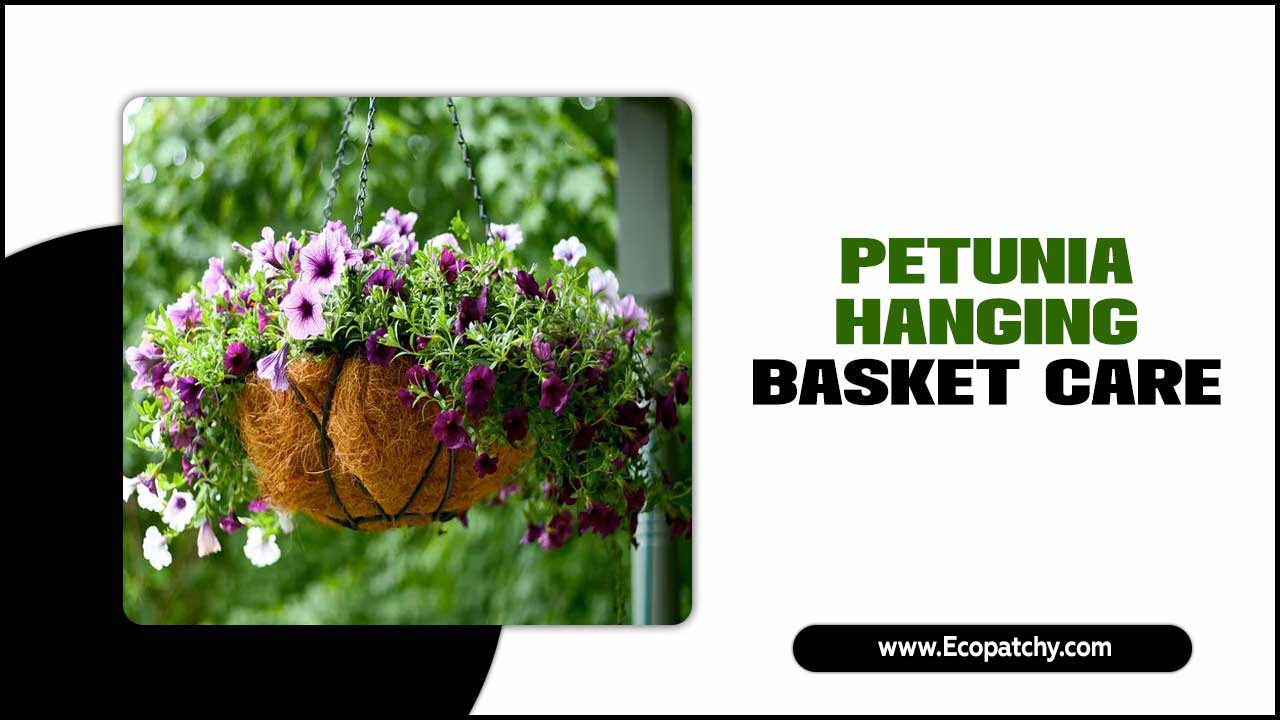
How To Keep Petunia Hanging Basket Care? 10 Tips
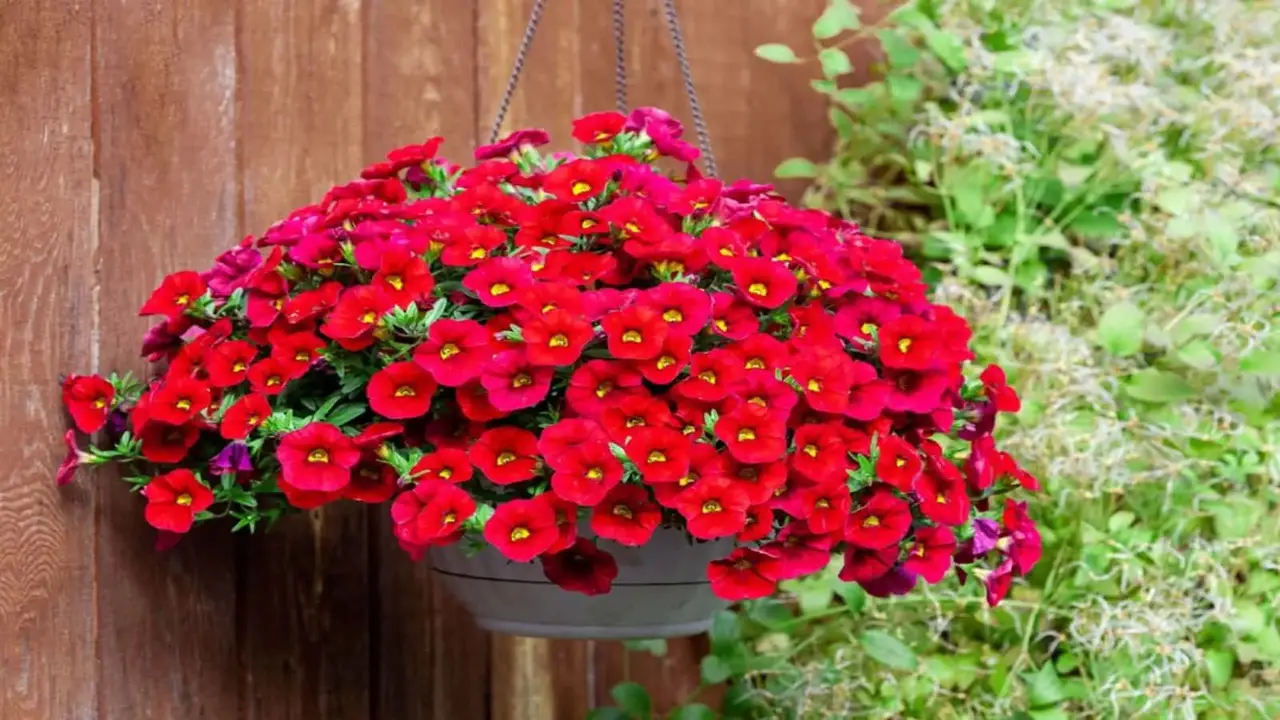
Petunia hanging baskets can be a beautiful addition to any outdoor space, but they require some care to keep them looking their best. Following these tips ensures that your petunia hanging basket remains healthy and vibrant throughout the growing season. Here are 10 tips to help you keep your petunia hanging basket care healthy and vibrant:
Plant Petunias In Spring
Planting petunias in spring is essential for their successful growth. It’s important to wait until the danger of frost has passed before planting them. Choose healthy petunia plants with vibrant foliage from a local nursery. Consider the USDA hardiness zones specific to your area for the optimal planting time. Ensure proper air circulation by providing enough space between plants. This will help the petunias thrive and produce beautiful flowers.
Choose A Sunny Spot
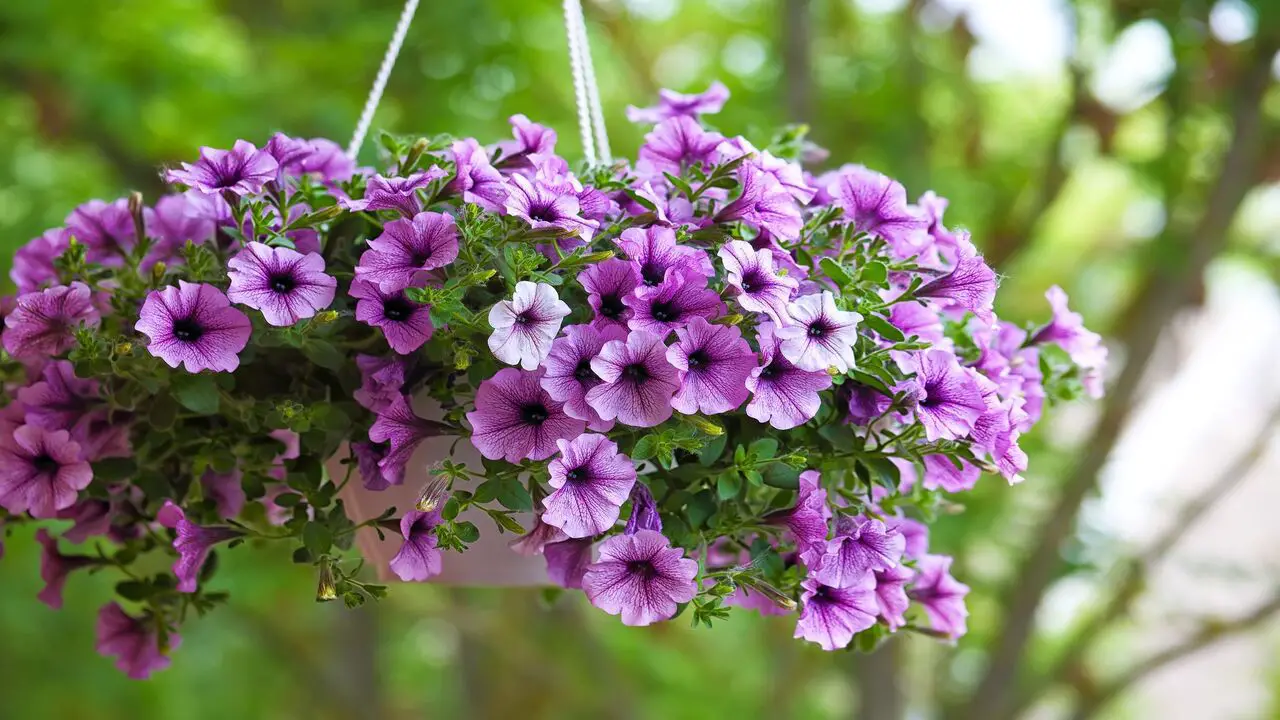
When caring for petunia hanging baskets, choosing the right spot is crucial. Petunias thrive in full sun and require at least six hours of direct sunlight daily. When selecting a location for your hanging basket, look for an area that receives ample sunlight throughout the day.
This will ensure your petunias receive the light necessary to grow and bloom beautifully. Remember that petunias can tolerate some shade, but they will produce fewer flowers and may have a leggy appearance. By providing your petunia hanging basket with a sunny spot, you’ll set them up for success and enjoy a vibrant display of colorful blooms all season long.
Use Potting Soil
When caring for petunia hanging baskets, using high-quality potting soil is important. Look for potting soil with good drainage to prevent root rot and organic matter for added nutrients. Avoid using garden soil, as it may not provide proper drainage. Add soluble fertilizer to the soil for extra nutrients. Using the right potting soil will ensure your petunias thrive and produce beautiful flowers.
Feed Petunias With Fertilizer
To ensure the health and vitality of your petunia hanging basket, feeding them with fertilizer is essential. Choose a balanced liquid fertilizer and apply it according to the package instructions. During the growing season, feed your petunias every two weeks.
For continuous feeding, consider using a slow-release fertilizer. Remember not to over-fertilize, as it can cause damage. You’ll see your petunias flourish with beautiful flowers throughout the season by providing the right nutrients.
Water Regularly
When caring for petunia hanging baskets, one of the most important tasks is to water them regularly. Petunias are known for their love of water, and they thrive when their soil is kept consistently moist. However, it is important to strike a balance and avoid overwatering, as this can lead to root rot and other issues.
To ensure that your petunia hanging basket receives the right amount of water, check the soil daily and water whenever it feels dry to the touch. During hot summer, you may need to water more frequently to prevent the plants from drying out. Remember, a well-watered petunia hanging basket will reward you with vibrant blooms all season long.
Prune To Promote Growth
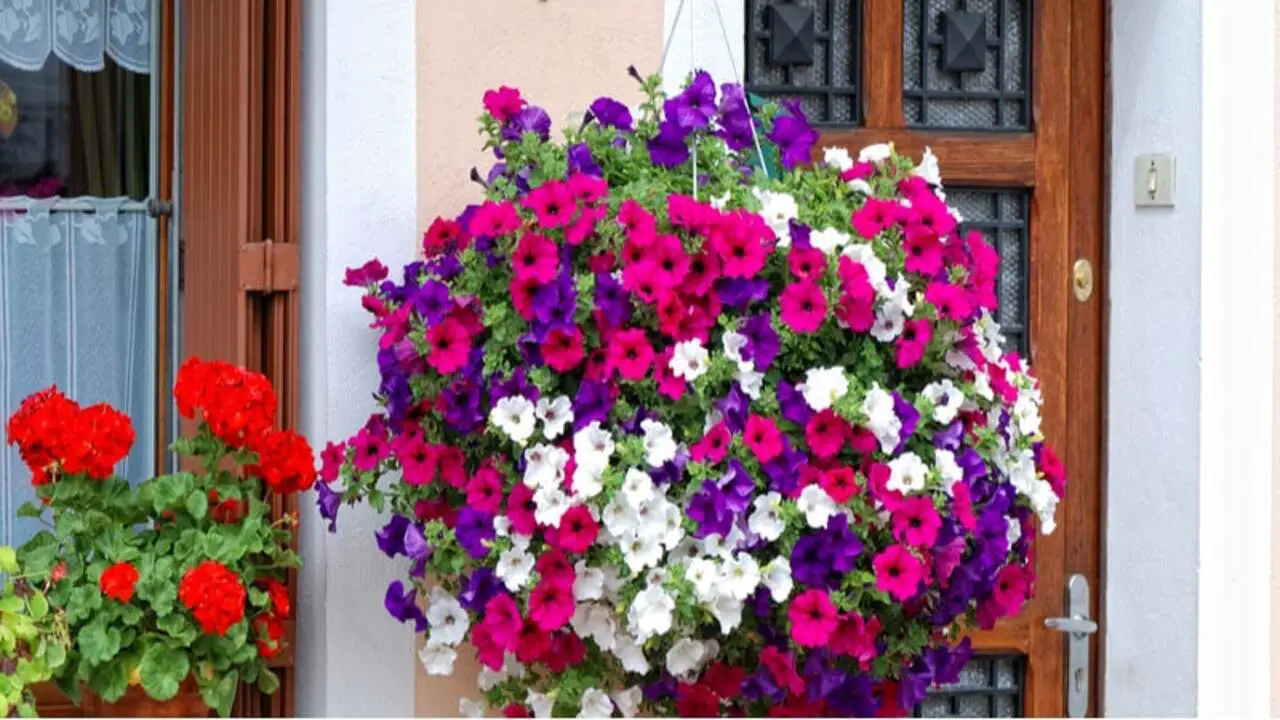
Pruning is essential to caring for petunia hanging baskets and can greatly promote growth and overall health. Regular pruning helps remove dead or wilted flowers, which not only improves the plant’s appearance but also encourages new blooms to form. Additionally, pruning can help shape the plant and prevent it from becoming too leggy or overgrown.
When pruning petunias, using sharp, clean scissors or shears and making clean cuts just above a set of healthy leaves or buds is important. This will ensure that the plant heals properly and continues to grow vigorously. Pruning should be done regularly throughout the growing season to maintain the health and beauty of your petunia hanging basket.
Deadhead Blooms
To ensure a continuous burst of fresh blooms throughout the growing season, it’s important to deadhead petunias. Regularly removing faded or wilted flowers stimulates the production of new blooms. When deadheading, make clean cuts just above a set of healthy leaves. This prevents the formation of seed pods and allows the plant to focus its energy on producing more beautiful flowers. Enjoy the rewards of rejuvenated plants and vibrant petunia displays.
Remove Diseased Leaves
When caring for petunia hanging baskets, it is important to regularly remove any diseased leaves. Diseased leaves can signify fungal or bacterial infections, which can spread and harm the entire plant if left untreated. To remove diseased leaves, simply pinch them off at the base with your fingers or use clean pruning shears.
Be sure to dispose of the diseased leaves in a sealed bag or trash bin to prevent the spread of disease. Removing diseased leaves promptly, you can help keep your petunia hanging basket healthy and vibrant throughout the growing season.
Divide Petunias Every Two Years
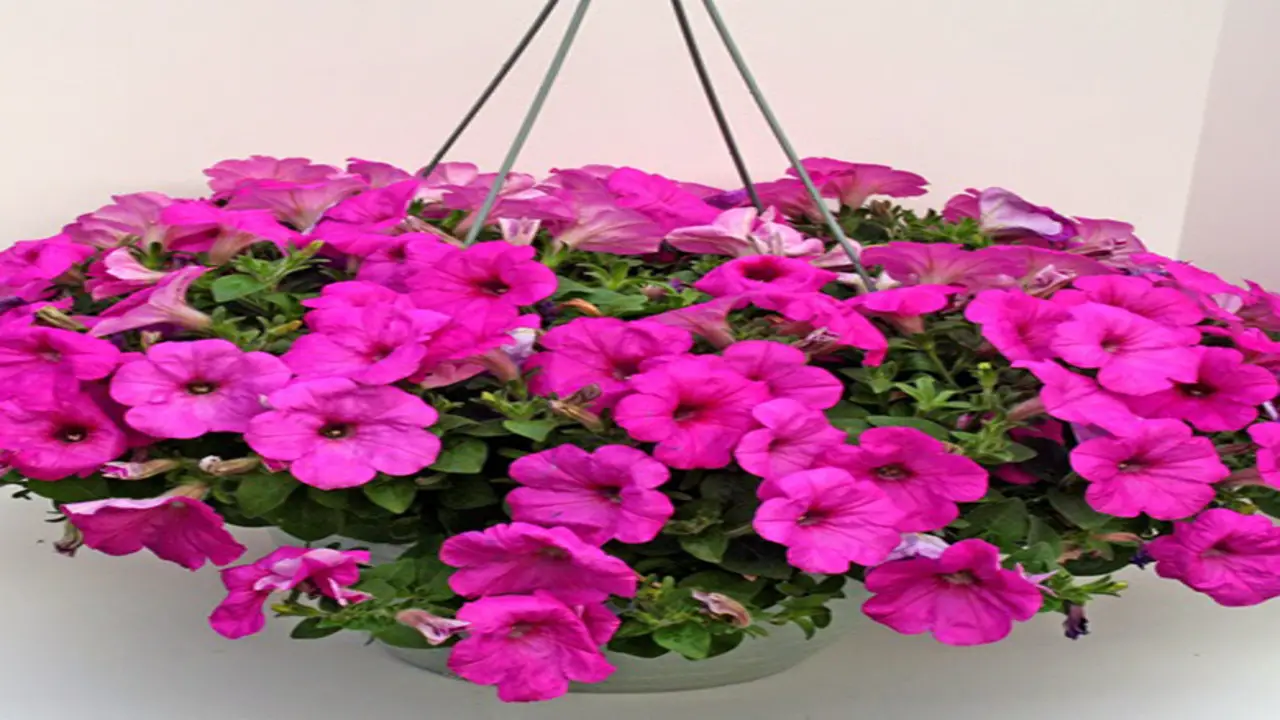
Dividing petunias every two years is an important aspect of their care. Over time, petunias can become overcrowded and start to lose their vigor and flowering capacity. By dividing them every two years, you can ensure they have enough space to grow and thrive.
To divide petunias, gently lift the plants from the soil and separate them into smaller clumps, ensuring each division has a healthy root system. Replant the divisions in well-draining soil and water them thoroughly. Dividing petunias not only helps to rejuvenate the plants but also promotes better air circulation, reducing the risk of disease and promoting healthier growth overall.
Bring Petunias Indoors In Cold Weather
As the weather starts to get colder, it is important to take steps to protect your petunias from the harsh conditions. One way to do this is by bringing your petunias indoors during cold weather. Petunias are sensitive to frost and freezing temperatures, so bringing them inside when the temperature drops below 50 degrees Fahrenheit is best.
Before bringing them indoors, gently remove any dead or dying flowers and leaves, as they can attract pests and diseases. Once inside, place your petunias in a location that receives bright, indirect sunlight and moistens the soil. With proper care, your petunias can thrive indoors until the weather warms up again.
Tips To Make Petunia Hanging Basket Care Easier

Taking care of petunia hanging baskets can be a rewarding and enjoyable experience. By following these tips, you can simplify the care of your petunia hanging basket and enjoy beautiful blooms all season. To make the care process easier, here are some helpful tips to keep in mind:
- Choose The Right Location: Petunias thrive in full sun, so choose a spot that receives at least 6 hours of direct sunlight daily.
- Water Regularly: Petunias have shallow roots, so they need regular watering to keep the soil moist but not waterlogged. Check the soil daily and water when it feels dry to the touch.
- Fertilize Regularly: Use a balanced, water-soluble fertilizer every 2-4 weeks to provide essential nutrients for healthy growth and abundant blooms.
- Deadhead Spent Flowers: Removing faded or dead flowers will encourage continuous blooming throughout the season.
- Prune And Trim As Needed: Regularly trim back leggy or overgrown stems to promote bushier growth and maintain an attractive shape.
- Monitor For Pests And Diseases: Check for common pests like aphids or fungal diseases like powdery mildew. Treat any issues promptly to prevent further damage.
Conclusion
Follow these simple tips to keep your petunia hanging basket looking beautiful and thriving. Plant your petunias in the spring, choose a sunny spot with well-draining soil, and regularly feed them with fertilizer. Be sure to water them regularly and prune them to promote growth.
Remove any diseased leaves and deadhead blooms to encourage new growth. Every two years, divide your petunias to keep them healthy. And when the weather turns cold, bring your petunias indoors to protect them. By following these tips, you can make petunia hanging basket care easier and enjoy beautiful blooms all season long.
Frequently Asked Questions
1.How Do You Keep Hanging Petunias Looking Good?
Ans: To keep your hanging petunias looking good, water them regularly and avoid letting them dry out completely. Additionally, fertilize every two to three weeks for healthy growth and blooms. Pinch back the stems for bushier growth and deadhead spent blooms to encourage more flowers.
2.How Do You Maintain A Petunia Hanging Basket?
Ans: To keep your petunia hanging basket thriving, water it regularly to maintain the right moisture level. Pinch back leggy stems and remove spent blooms to encourage bushier growth. Fertilize with a balanced fertilizer every two weeks and check for pests and diseases regularly.
3.How Long Do Petunias Last In Hanging Baskets?
Ans: Petunias can thrive in hanging baskets for months with proper care. Factors like temperature, sunlight, and watering affect their lifespan. Deadheading promotes new growth and extends the blooming period. Replacing soil and fertilizing help maintain healthy plants and prolong their life.
4.Should I Cut Back My Petunia Hanging Basket?
Ans: Yes, it is recommended to cut back your petunia hanging basket regularly. This will promote bushier growth and encourage more blooms. Cut back any leggy or straggly stems to promote a fuller appearance. Deadheading spent blooms regularly also helps to keep the plant healthy and blooming.
5.How Do You Take Care Of Petunias In A Hanging Basket?
Ans: To take care of petunias in a hanging basket, water regularly to keep the soil moist but not waterlogged. Fertilize every two weeks with a balanced fertilizer for abundant blooms. Deadhead spent flowers to encourage new growth. Provide at least 6 hours of direct sunlight daily and protect from strong winds.


